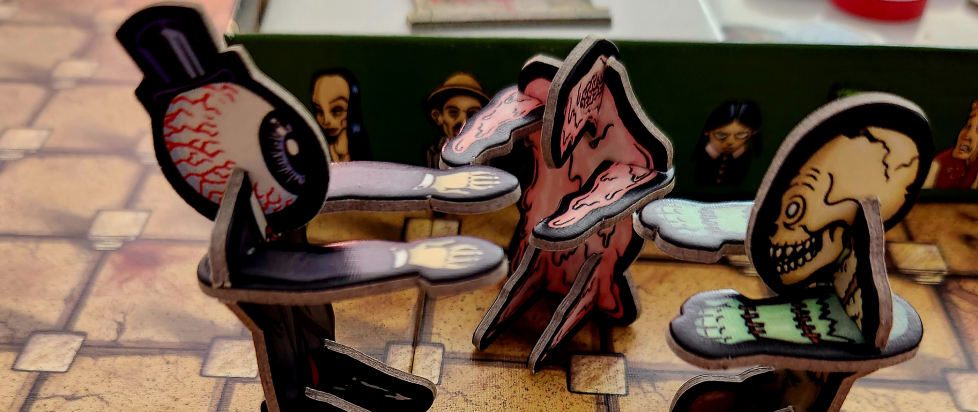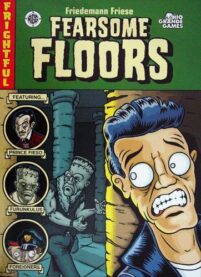
Fleeing Fast from Freaky Fiends: Finding Fun with Fearsome Floors
I see board games in the store and they always look so cool and then I buy them and bring them home, I’m so excited to open them, and then I play them, like, twice… This column is dedicated to the love of games for those of us whose eyes may be bigger than our stomachs when it comes to playing, and the joy that we can all take from games, even if we don’t play them very often.
There are some surprising parallels between last month’s game and this one. Like 13 Dead End Drive, Fearsome Floors is put out by an established company. In this case, that’s Rio Grande Games, who rose to prominence on the influx of European-style games into the American board game scene, releasing such beloved and genre-defining titles as Dominion, Race for the Galaxy, and Puerto Rico, to name just a few.
Indeed, Fearsome Floors is one of those European imports, hailing from eccentric German game designer Friedemann Friese, whose fixation on the color green and massive use of alliteration of the letter F can sometimes get lost in translation but certainly helps to set his games apart. In the States, he’s probably best known as the designer of Power Grid, also from Rio Grande Games, but he’s also done Fabled Fruit, Famiglia, Fauna, and others. Fearsome Floors is actually a sequel of sorts to another game, 2002’s Fische Fluppen Frikadellen, which sees players acting as merchants trying to trade for a variety of items (all of which start with the letter F) in order to acquire three fetishes.
The storyline of Fearsome Floors picks up right where Fische Fluppen Frikadellen left off, and the principal artist for both games is the same, Lars-Arne “Maura” Kalusky, lending the two a fine sense of continuity if, unlike me, you’ve ever actually seen a copy of Fische Fluppen Frikadellen. Fortunately, no familiarity with that game is required to play this one, and though the storylines link up, the play style is entirely different.
Fearsome Floors is, according to Rio Grande’s own site page, “a race game for 2-7 players. The players must move through a dungeon as quickly as possible while being pursued by Furunkulus, a monster who is chasing them.” The appeal for me may be relatively obvious from that synopsis and, if it’s not, a glance at the box’s cover art will solve the mystery. The cover design for Fearsome Floors is intentionally meant to evoke the old covers of the EC horror comics, complete with the iconic circles highlighting characters along one side.
While the gameplay itself is straightforward enough – players move pieces through a crumbling dungeon while trying to avoid a monster, with each move revealing how many “movement points” will be available for the next one – the art style within the box continues the trend of the cover. Besides the dungeon itself there are “blood slicks” and other macabre touches, including character tokens that are obvious nods to the Addams Family. But the real selling point for horror hounds is the monster.

While the one on the cover is obviously a variant on Frankenstein’s famous creation, there are actually several monster options in the box, all of them made by assembling cardboard pieces into little stand-ups. This means that there are a number of possible permutations of Furunkulus that you can make using different arms, torsos, heads, and legs. In addition to the standard Frankenstein creature, there’s a slime monster, and a couple of variants that use a tuxedo-clad torso. One of the heads is even a clear nod to the rock group the Residents.
I mentioned multiple parallels earlier between this and 13 Dead End Drive, but so far I’ve only really talked about one – that both are odd games put out by fairly mainstream game companies. Here’s another: Both this and 13 Dead End Drive are using relatively straightforward game mechanics to harken back to a very specific sub-set of horror-adjacent storytelling. In 13 Dead End Drive, that’s old dark house pictures. In Fearsome Floors, despite the EC Comics styling of the box art, it’s Euroshock cinema of the kind that was popular in the ‘60s and ‘70s. All gothic castles and women in peril and mad scientists and deranged noblemen and monsters in dungeons.
Besides Furunkulus itself, in its various incarnations, and the castle dungeon board, there is bad guy Prince Fieso, who looks like Vincent Price and whose crumbling castle you are trying to escape. The various folks trying to make their getaway are from all over the spectrum, when it comes to their chronological origins. Alongside the aforementioned Addams Family members, there are greasers, a noir-ish detective or two, as well as a Trekkie, a Buffy the Vampire Slayer fan, and an aficionado of The X-Files.
All of this is just set dressing to the gameplay, however, which could honestly have just about any theme, so long as it required you to get out of a location, and avoid something moving around within. One could easily see Fearsome Floors repurposed into a sci-fi variant in which a space station was about to self-destruct and one had to try to escape while avoiding a rogue robot or an aggressive alien. (This would actually make a better adaptation of the Alien franchise than many other board game adaptations of it have been.)
There’s one other parallel between this and 13 Dead End Drive, though it’s one that only applies to me, personally. In spite of how obviously such a game seems tailored to my particular interests and aesthetics, I had never heard of it prior to spotting a copy at a neighborhood garage sale a few months ago. Naturally, I picked it up based solely on the styling of the cover art alone, meaning that, like 13 Dead End Drive, it came home with me from a yard sale, and has become a staple of my collection since.
———
Orrin Grey is a writer, editor, game designer, and amateur film scholar who loves to write about monsters, movies, and monster movies. He’s the author of several spooky books, including How to See Ghosts & Other Figments. You can find him online at orringrey.com.





